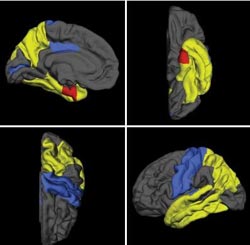Gene variation associated with brain atrophy in mild cognitive impairment

Medial, inferior, superior, and lateral images of a three-dimensional FreeSurfer reference brain model show regions of accelerated atrophy in the presence of APOE epsilon 4 in subjects with MCI. Effect size of the APOE epsilon 4 acceleration of cortical atrophy is depicted by color: Blue signifies a magnitude of Cohen d value of less than 0.25; yellow, 0.25.35; and red, more than 0.35. Gray areas were not examined.<br><br>Credit: Radiological Society of North America<br>
The study focused on the gene apolipoprotein E (APOE), the most important genetic factor known in non-familial Alzheimer's disease (AD). APOE has different alleles, or gene variations, said the study's senior author, Jeffrey R. Petrella, M.D., associate professor of radiology at Duke University School of Medicine in Durham, N.C.
“We all carry two APOE alleles, and most people have at least one copy of the APOE epsilon 3 (ɛ3) variant, which is considered neutral with respect to Alzheimer's risk,” Dr. Petrella said.
The less common epsilon 4 (ɛ4) allele, in contrast, is associated with a higher risk for development of AD, earlier age of onset, and faster progression in those affected, as compared with the other APOE alleles.
Dr. Petrella and colleagues recently analyzed data from the Alzheimer's Disease Neuroimaging Initiative (ADNI) involving 237 patients, mean age 79.9, with MCI, a slight but noticeable decline in cognitive ability that is tied to a higher risk of AD. The researchers used MRI to measure brain atrophy rates in these patients over a 12- to 48-month period.
The ɛ4 carriers in the study group exhibited markedly greater atrophy rates than ɛ3 carriers in 13 of 15 brain regions hypothesized to be key components of the cognitive networks disrupted in AD.
“The results showed atrophy in brain regions we know are affected by AD, in a population of patients who do not have AD, but are at risk for it,” Dr. Petrella said. “This suggests the possibility of a genotype-specific network of related brain regions that undergo faster atrophy in MCI and potentially underlies the observed cognitive decline.”
The researchers did not explore why APOE ɛ4 might accelerate atrophy, but the affect is likely due to a combination of factors, noted Dr. Petrella.
“The protein has a broad role in the transport and normal metabolism of lipids and a protective function on behalf of brain cells, including its role in the breakdown of beta-amyloid, one of the proteins implicated in the pathophysiology of AD,” he said.
With MRI playing an increasingly prominent role in MCI research, Dr. Petrella predicted that increased knowledge about the effects of APOE will improve the design and execution of future clinical trials. For instance, researchers could enrich their samples with å4 patients in MCI prevention trials to better determine potential treatment effects on brain regions vulnerable to degeneration.
The advances in knowledge will also help expand the role of MRI measures in clinical trials investigating novel drugs with potentially disease-modifying capabilities.
“Current FDA-approved drugs treat symptoms, but don't modify the underlying cause of the disease,” Dr. Petrella said. “We want to make continued inroads toward the goal of developing and testing drugs that modify the disease process itself.”
“Mapping the Effect of the Apolipoprotein E Genotype on 4-Year Atrophy Rates in an Alzheimer's Disease-related Brain Network.” Collaborating with Dr. Petrella were Christopher A. Hostage, M.D., Kingshuk Roy Choudhury, Ph.D., and P. Murali Doraiswamy, M.B.B.S., FRCP. For the Alzheimer's Disease Neuroimaging Initiative.
Radiology is edited by Herbert Y. Kressel, M.D., Harvard Medical School, Boston, Mass., and owned and published by the Radiological Society of North America, Inc. (http://radiology.rsna.org/)
RSNA is an association of more than 53,000 radiologists, radiation oncologists, medical physicists and related scientists promoting excellence in patient care and health care delivery through education, research and technologic innovation. The Society is based in Oak Brook, Ill. (RSNA.org)
Media Contact
All latest news from the category: Health and Medicine
This subject area encompasses research and studies in the field of human medicine.
Among the wide-ranging list of topics covered here are anesthesiology, anatomy, surgery, human genetics, hygiene and environmental medicine, internal medicine, neurology, pharmacology, physiology, urology and dental medicine.
Newest articles

Superradiant atoms could push the boundaries of how precisely time can be measured
Superradiant atoms can help us measure time more precisely than ever. In a new study, researchers from the University of Copenhagen present a new method for measuring the time interval,…

Ion thermoelectric conversion devices for near room temperature
The electrode sheet of the thermoelectric device consists of ionic hydrogel, which is sandwiched between the electrodes to form, and the Prussian blue on the electrode undergoes a redox reaction…

Zap Energy achieves 37-million-degree temperatures in a compact device
New publication reports record electron temperatures for a small-scale, sheared-flow-stabilized Z-pinch fusion device. In the nine decades since humans first produced fusion reactions, only a few fusion technologies have demonstrated…





















